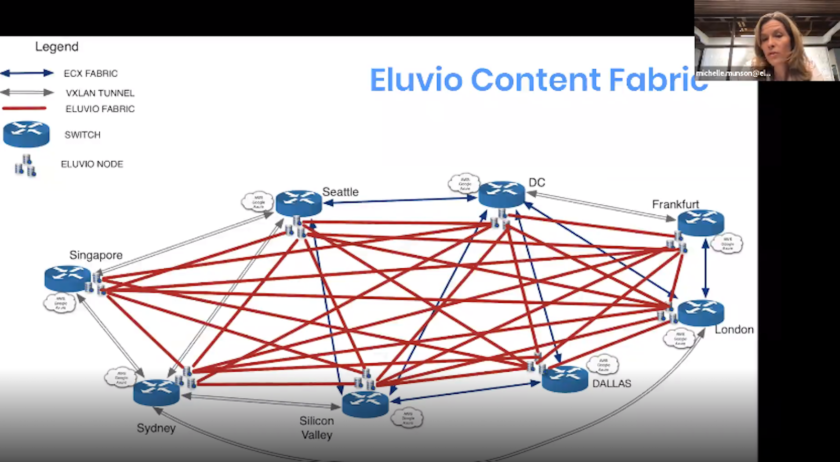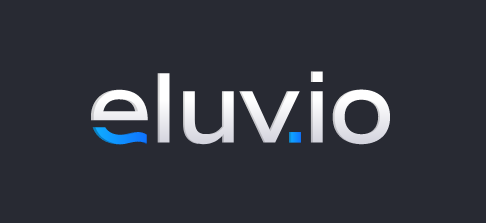HITS

Eluvio Touts Content Fabric Benefits, Discloses Future Enhancements
Story Highlights
Eluvio’s founders highlighted the benefits of the company’s Content Fabric during a recent webcast, while disclosing the roadmap for enhancements that are planned for the new global software network for premium video.
During demonstrations provided during “The Eluvio Content Fabric — A Live Webcast for Content Providers,” Michelle Munson, the company’s CEO and co-founder, and Serban Simu, its president and co-founder, explained how Content Fabric can be used as one simple, high performance, low-cost backend for premium video distribution.
And they explained how this single, backend source for master asset servicing (media, metadata and code) allows for streaming and file-based video presentation to be delivered globally, from source objects to consumer, with ultra-low latency, and no file copies involved. Meanwhile, an embedded blockchain ledger enables personalization, rights control, monetization and re-use of media and metadata across all properties.
“One of the things that we’re very encouraged by is the fact that the many benefits that this platform brings are really punctuated” now as the media industry is facing challenges from the COVID-19 pandemic, according to Munson.
She is also hopeful that organizations will find the Eluvio Content Fabric global software network helpful as “you think about really modernizing your media business,” she told listeners.
 Moving on to highlight what’s next in 2020 for the Content Fabric, she said: “We are engaged in some very exciting pilots around composed linear channels against schedules, and you will see us coming out with some productized versions of that later on in this year.”
Moving on to highlight what’s next in 2020 for the Content Fabric, she said: “We are engaged in some very exciting pilots around composed linear channels against schedules, and you will see us coming out with some productized versions of that later on in this year.”
The company is also working on support for frame-accurate ad insertion, which is part of the composed linear channels effort, she noted, adding that with the Eluvio solution, “you get the flexibility of client-side ad insertion, but the precision of server-side ad insertion because the Fabric does it for you.”
Also planned are more video features, she said, noting: “We’re constantly adding those … . One of the great things about being an agile, engineering-driven startup is that we can move at lightning speed. And so, if you need something, you tell us, and we go.”
The company is also “constantly making an ever bigger Fabric,” she said, noting “we will continue to add to” the regions that it is available for.
Also planned: Building support for downloadable asset packages, expanded video search, and a shift to a complete self-service model, she pointed out.
Asked during the Q&A if there is a way to integrate third-party digital rights management solutions (DRM) with Eluvio Content Fabric, Simu explained: “The Fabric comes with a built-in version of DRM for the various platforms. But an external encryption as well as maybe an external DRM service can be supported as well if there is a need for a special kind of DRM.” Watermarking is also built-in, he noted.
 Asked if the service options include real-time subtitling or closed captioning generation, Munson said: “We have not built anything that does real-time captioning. But one thing that does work very nicely” with the Fabric is the Optical Character Recognition (OCR) in its machine learning “picks up any subtitles so you end up indirectly with a transcription if the subtitles are already applied directly on the content.”
Asked if the service options include real-time subtitling or closed captioning generation, Munson said: “We have not built anything that does real-time captioning. But one thing that does work very nicely” with the Fabric is the Optical Character Recognition (OCR) in its machine learning “picks up any subtitles so you end up indirectly with a transcription if the subtitles are already applied directly on the content.”
In addition, she disclosed: “A couple of the subtitling companies have discussed partnering with us and that would make for a nice opportunity.”
An additional advantage stands to be provided by 5G wireless technology, according to Munson, who explained: “One of the fantastic benefits of 5G is it concentrates bandwidth where there’s the most audience — and with an architecture like this, that’s really great because it means that you’ve got the resource where you also have the revenue for content publishers. It really just makes it even more scalable in these urban environments.”
Concluding the webcast, she added: “We think one of the mistaken ideas is that you solve these problems of scale through brute force and just dump in tons of compute, for example, or storage in order to try to fill out your edge.” With intelligence that “avoids having to do much of that, you can essentially have a vastly slimmer and less bloated architecture that performs better,” she said.









